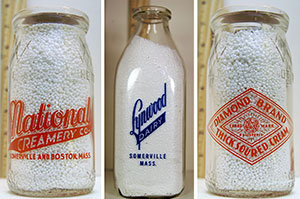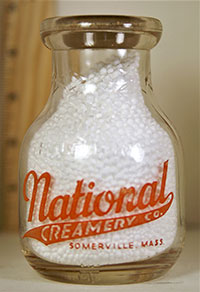
By Peter Lesses
As originally published in the March 2021 issue of The Milk Route
In June 2018 I donated an extensive collection of Somerville milk bottles and go-withs to the Somerville Museum, a small museum in the city of Somerville, Massachusetts. I wrote The Somerville, Mass. Dairy Collection booklet to document the collection and to explain the history of the Somerville dairy industry for New England collectors.
Barbara Mangum, the museum’s director, approved the accession and the publication of the booklet, while the trustees secured any necessary copyrights, especially for the pictures.
The booklet relies on the two newer Massachusetts dairy lists: Massachusetts Milk Bottles by Town in Ascending Order, originally assembled by Lou Schadlich and Bill Devine, and later updated by Carl Smith. Another source was the set of Somerville Business Directories in the Somerville Public Library from 1872-1933, with some unfortunate gaps.
 Three members of the Merrimack Valley Bottle Club deserve credit for helping to find rare bottles and go-withs: Al Morin of Lowell, MA, Jim George of Milford, NH, and Bob Strand of Groton, MA. I spent a whole afternoon with Al taking notes on machine bottle marks, his specialty.
Three members of the Merrimack Valley Bottle Club deserve credit for helping to find rare bottles and go-withs: Al Morin of Lowell, MA, Jim George of Milford, NH, and Bob Strand of Groton, MA. I spent a whole afternoon with Al taking notes on machine bottle marks, his specialty.
The Milk Route subscribers are familiar with his contributions to Bill Lockhart’s articles on the origin of milk bottles. I’d also like to thank Brad Blodget of Holden, MA, who specializes in Worcester County dairies. Brad sent me a copy of his article on the Bellows Falls Co-operative Creamery (BFCC) from the May 2008 issue of The Milk Route.
This article cleared up confusion over the common milk bottles from First National Stores – Boston; the company was actually in Somerville. The article also mentions that Calvin Coolidge was a stock holder in the newly formed BFCC.
The Somerville bottle collection
The collection represents 64 of the known 75 diaries.
- Six bottles presumably had tin tops: Philip Koen, E. Everett Giles; two different Highland Milk – D. A. Paige; Fred Smith, which has a tooled top; and F.S. Barnard, an acid etched pint “So2,” which has an odd-looking straight neck.
- Examples from seven other diaries are included because they distributed milk in Somerville: a half pint tin top with the original closure from Hampden Dairy of Everett, Mass., acid etched “So5” for delivery in this city; Elm Farm from Boston, owned by Whiting’s of Charlestown, which had a large store where the Goodyear Tire is currently located in Union Square; Cherry Valley Dairy of Everett, which had an agent at 53 Prescott Street that was just a home; W. H. Munhall and Harvard Farms, which were both located in Cambridge. Research proved that the William, who lived in Cambridge, and Martin, who lived in Somerville, owned a farm in New Hampshire, but W.H. had a license to sell milk in both cities; the Harvard Farms Somerville pint VR as well as the more familiar pint with Cambridge embossed on it.
- The most common bottles were Herlihy Bros. at 65 Somerville, Ave.; National Creamery Co. across the street at 66; F.S. Cummings; Giroux Bros.; Noble’s; Seven Oaks; and First National Stores. F.S. Cummings bottles usually have an embossed triangle upside down with the letters “F C S” across the front, with the C in the middle of the triangle; however, there is a half pint in the collection with the triangle right side up.
- In 2002 I came across a clear half pint cream bottle embossed “Lakeside Farm Dairy Co. Somerville” with a Mass “BB” Seal. The name was a puzzle because the city has no lakes; the only body of water in close proximity is the Mystic River, which flows along the northern border and empties into the harbor surrounding Boston. 10 VOLUME 486 The Somerville Milk Bottle Collection (continued)
A Few Anecdotes
- Brian Cohen told me a story about how his grandfather Sam Cohen, along with Sam’s brothers Phillip and Benjamin, started National Creamery Company (NCCo) in the early 1930s. They specialized in different kinds of cream cheese, some milk, and cream. The dairy operated for about 20 years until the National Dairy Company in Chicago, which became Kraft Foods, acquired them, along with NCCo’s fierce competitor Breakstone’s.
The comptroller for NCCo was William “Billy” Bloomberg (the father of Michael Bloomberg, the mayor of New York City from 2002-2013). Brian Cohen’s father Harold (the future owner of the Somerville Lumber chain) returned from business school at Indiana University and learned that Billy Bloomberg was giving away inside information to National Dairy. After a heated argument, Harold punched Billy in the nose. Michael Bloomberg, who was 13 at the time, remembers that his blessing had to be postponed, since his father had a black eye.
- In 1932 the Boston Globe reported on the robbery of 65-year-old Joseph Herlihy, the treasurer of the Herlihy Bros. Dairy. The robbery occurred while Herlihy, a partner for 40 years in the business, was driving through Charlestown on his way to make a deposit at a branch of the First National Bank of Boston.
Four assailants had trailed Herlihy from the Somerville plant and waited until he was blocked by traffic. When the robbers entered his car, Herlihy refused to hand over a leather bag and engaged in a furious struggle with one of the armed robbers, John E. “Muggsy” Morris. Herlihy managed to wrest a pistol from the robber, but not before a shot from the gun wounded a 17-year-old spectator.
While Morris was struggling with Herlihy, another robber removed a black leather bag from the other side of the car, containing $1,500 in cash and $500 in checks. This robber and two accomplices escaped on foot, abandoning their car, which was reported stolen an hour later. When the men first accosted Herlihy, one stepped into the car and said, “How do you do, Mr. Herlihy?” As Herlihy asked, “Who do you happen to be?” the holdup man pressed a .45-calibre pistol against Herlihy’s side and struck him a heavy blow on the mouth. Herlihy grabbed the gun away from the robber as a shot was fired, accidentally grazing the leg of a startled bystander.
As a small crowd began to gather, Muggsy Morris tried to escape but was brought to the ground with a flying tackle by Robert Bradley, an auto mechanic who worked nearby. Thomas Herlihy, Joseph’s son, had seen the holdup men’s car following his father leaving the dairy, so he followed and he reached the scene of the crime just as it was occurring. He assisted in holding Morris until Traffic Officer William Sheehan arrived and placed Morris under arrest. Joseph Herlihy said, “If I was 25 instead of 65, I could have done a better job than I did today.”
















Reader Comments